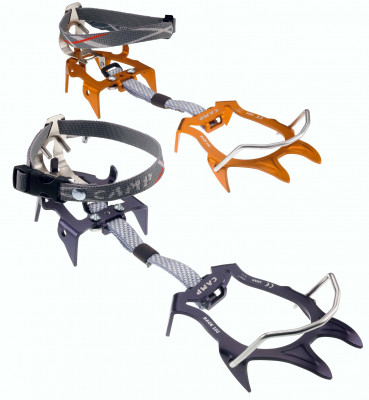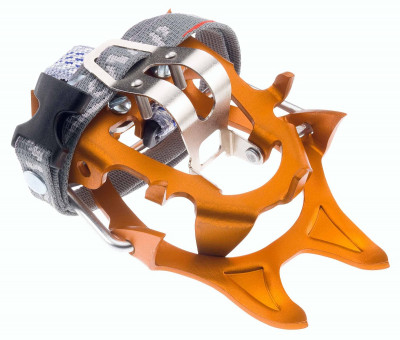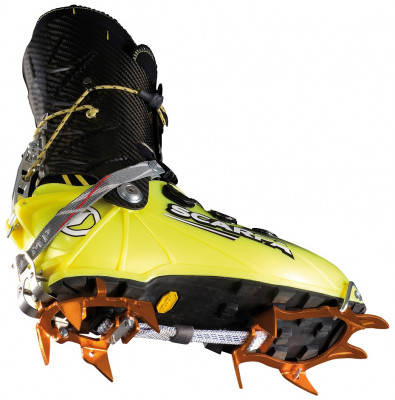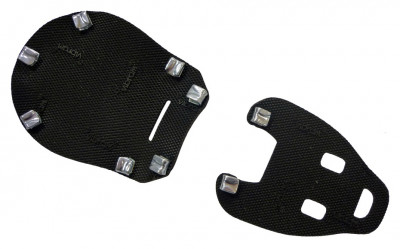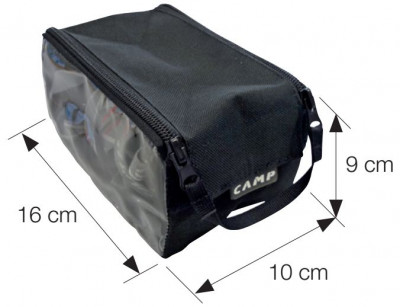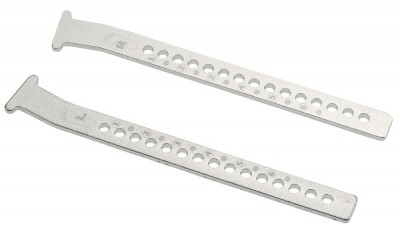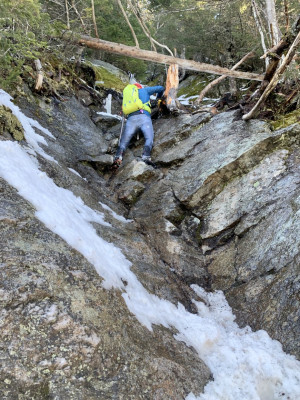Ultralight, extremely packable, plug into tech fittings on rando boots. What more could you ask of a crampon designed for competitive ski mountaineering? Not much, as the CAMP Race 290 is the go-to crampon for technical rando races in Europe. The amazingly light weight is achieved with a special heel attachment that fit into the tech inserts on your ski boot combined with a flexible Dyneema strap linking the toe.
- The lightest 10 point crampons in the world!
- Patented heel attachment has tech binding pins that plug into alpine touring boots.
- Dyneema® linking strap between toe and heel piece allow the crampons to fold on themselves for packability.
- It's possible to quickly twist the Dyneema straps to get a tighter fit in the field.
- Standard aluminum linking bars are also included for easier adjustment (24g/foot).
- Different colors for left and right for easy identification when you're redlining.
- Includes a handy carrying case to prevent puncturing your pack or things in it.
- Optional rubber anti-balling plates (39 grams) help reduce dangerous snow build-up under your feet.
- Comes with a flat wrench (21 grams) that makes a nice addition to a repair kit.
* Please note the Race 290 crampons are designed to work only with modern alpine touring boots with tech inserts, as the heel has Dynafit style pins. Also, CAMP recommends that you don't use these on boots larger than size 10.5 US (28 mondo) due to the short length and decreased size of the front platform. Race boots can go a little higher. For larger boots, check out the XLC 390.
| Specifications | |
|
Weight |
146g |
| Weight (pair) | 292g |
| Points | 10 |
| Specs Verified | Yes |
| Design | |
|
|
7075 Aluminum |
| Skimo Co Says | |
| Usage | Skimo racing, speed ascents |
| Notes | Heel plugs into tech inserts on ski boots |
| Bottom Line | Lightest crampons in the world |
| Compare to other Crampons | |
Questions & Reviews
I need to buy a replacement screw
These things pack down so small and are so light that I tend to just leave them in my UD 18L pack and don't worry about having them when I need them.
The other thing that I noticed that other pointed out is that the toe bail is too wide. Fortunately, with a bench vise, you can easily (gently) reshape the bail a bit, and now my toe fits great - no more slipping back and forth side-to-side.
They're my first set of crampons, and hopefully one day I'll have the skills to warrant a more-serious set, but for now these are about as good as I could ask for.
I have used these crampons 4 times while booting a few thousand feet of hard (not bulletproof / blue) spring ice at my local resort once skinning became impossible.
They fit pretty well with my La Sportiva Spitfires. Took a bit of fiddling / testing with the Dyneema adjustment to get the tightest possible fit but was achieved without much effort.
The toe bail does not fit my boot PERFECTLY ... so there is some side to side motion when French Stepping (disconcerting at first) but after more use i stopped worrying about it.
Darn light and pack so small. I would recommend.
Background on product familiarity: See my XLC 390 review.
First, the first impressions out of the box: If you’re accustomed to steel crampons, or even some competing aluminum crampons, then you’re in for a shock at the weight savings, even compared to CAMP’s other aluminum models. The other shock is how you can fold up the crampons, because of the flexible Dyneema connector strap. The points are noticeably duller and less aggressively designed than with a steel crampon, but these obviously aren’t intended for vertical ice climbing or mixed climbing. And compared to the XLC 390 (or steel-insert XLC Nanotech), only 10 points instead of 12.
The toe bail is a bit too wide for optimum fit, but that hasn’t caused any noticeable problems on CAMP’s other aluminum models that I’ve used with the same toe bail. However, the combination of the “Tech”-style heel pins (with no micro adjustment) and the lateral play of the Dyneema connector strap entails questionable fit and security without any modifications. During some initial practice sessions, I struggled to set the Dyneema connector length short enough to provide sufficient tension for climbing, yet still loose enough to allow for relatively easy entry and exit.
Eventually, I figured out two very simple yet highly effective modifications: dremmel off the heel’s rear nubbin/stopper, and dremmel off ~4mm of the heel pins (plus round off the resulting sharp ends a bit). Then set the Dyneema connector length as tight as you possibly can for relatively easy entry and exit (facilitated by the springy steel of the rear post of sorts). And practice first (with a large flathead screwdriver at the ready) to see if you can shorten up the strap length any further before using them for real.
Second impressions, in use: With two simple modifications and the length dialed in just right, these are by far my favorite crampons. The modified attachment system has been very secure, although my longest bsl has been 287mm. The weight savings add up, and the packability is outstanding. When anticipating the need to affix crampons yet not wanting to reach inside my pack, I can easily rack them up on a Black Diamond Ice Clipper. (I’ve even folded them inside my pocket just to see if it could be done, but obviously not such a great idea for real!)
Climbing purchase has always been sufficient for me, but the bite of the 10 points is slightly yet sometimes noticeably compromised compared to the 12 points on the XLC 390 (or the steel-insert XLC Nanotech). Personally, with my climbing conditions and comfort level, I’ve been fine with the CAMP 10-point design. But if you’re suspicious of the climbing ability of aluminum crampons, or doubtful of your own climbing abilities, or really want to push the limits of aluminum crampons, then consider instead the 12-point XLC 390 (or steel-insert XLC Nanotech).
If you need to swap crampons among multiple pairs of boots, then look elsewhere: even after I was experienced getting them dialed in just right for a 287mm Dynafit TLT5, adjusting them again took a long time for a 279mm Dynafit EVO, and then ditto for a 279mm Scarpa Alien 1.0 (whose crampon length was about 1.5mm longer than the EVO, yet whose binding length was about 1.5mm shorter).
And finally, as with all CAMP aluminum crampons, I read a criticism that the buckle’s quick release can be difficult to manipulate, but I’ve always used thin gloves with these, so no problems for me personally.
Third impressions, for long-term durability: I’ve read criticisms of aluminum crampon durability. But I’ve never seen a picture of a broken crampon point, whether CAMP or another brand. (I have seen a broken toe bail on another brand, but with a much different design.) The points will definitely dull more quickly from even limited and careful walking on rocks, but a few seconds with a file will restore the original point. The Dyneema strap might seem suspect, but my understanding is that it can easily withstand this kind of application.
Still though, no signs of any wear.
Also, a little trick (even if it might be Captain Obvious territory): if you want to tighten up the fit just a *little* bit, instead of readjusting the length, just twist the strap to take up some slack.
On the performance front, they hold a good grip on firm snow like any 'walking' style aluminum crampon. Obviously not meant for ice or ice climbing, but on a smooth patch of ice, they'll do better for you than your rubber soles will!
There are a few things to note about the 290's. They're tricky to get on your boot. I actually seat the heel piece, then lever the toepiece into position over my boot's toe flange with an ever-present Whippet. I've had good success doing this, and not so much so in putting them on the other way. I note that the reviewer Eric C made the same comment, but it's been really beneficial to do micro-adjustments by simply twisting the toepiece while keeping the heel stationary. This is so because I use several pairs of boots that are have a similar, but not identical, bsl. They're only fitted precisely to one pair of boots in my stable..
Once precisely adjusted and on the boot with the Dyneema stretched tautly, the crampons don't come off. However, the toepiece does move around on the boot in a way that standard crampons don't. It's a bit disconcerting until you realize the toe bar is a bit wide, and that's just the nature of the beast.
It's tough to get them precisely adjusted with the seeming cave-man technology that holds the Dyneema down. It took me three tries to get it right. But if I'd figured out the 'twisting' secret earlier, I'd have skipped the second and third adjustment phases..
Removing the crampons is easy - unbuckle the strap, and pull on it with a yanking motion. They should pop right off, as the heel piece that holds the Dynafit pins is easily flexed.
Overall, I love 'em, but I do hope one day, future models come with a slightly narrower toe bar to cut down on side-to-side movement.
Earn store credit by writing reviews. Learn more.






